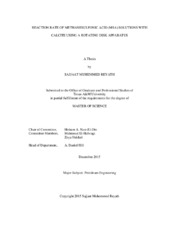| dc.description.abstract | Methanesulfonic acid (MSA) has been proven as a scale remover and, more recently, as a stand-alone stimulation fluid in carbonate acidizing. MSA is a strong alkyl sulfonic acid having a pK value of -1.9, and it dissolves carbonate and oxides with its calcium water-soluble salts. Although the acid has many promising results for acidizing, little is known in relation to its detailed kinetics. This study aims to understand the reaction profile of MSA to provide relevant information to scientists and engineers to design acidizing jobs with this improved fluid.
The dissolution of calcite in MSA was studied with the aid of a rotating disk system at 1000 psig in the temperature range 73-250°F. As a result of this study, dissolution rate parameters for this system were reported for the first time. Details of the approach for this study include using marble disks of 1.5-in. diameter and 0.7-in. thickness. The dissolution rate was found by measuring the calcium concentration in the effluent as a function of time using inductively coupled plasma optical emission spectrometry (ICP-OES). The effects of MSA concentrations (5 to 20 wt%), disk rotational speeds (100 to 1500 rpm), and temperature on the rate of dissolution were also investigated.
Experimental results showed that, within the range of temperatures tested, the dissolution rate of MSA with calcite was mass-transfer limited, even at high disk rotation speeds and at high temperatures. At 5 wt% MSA concentration and at room temperature (73°F), the rate of reaction was controlled by both mass transfer and surface reaction regime. The diffusion coefficient of a 5 wt% MSA fluid at 150°F was found to be 3.00 x 10^-4 cm^2/s, and at 250°F the diffusion coefficient was found to be 9.76 x 10^-4 cm^2/s. The acid diffusivity increased with increasing system temperature. At 5 wt% MSA, the effect of diffusion on temperature followed the Arrhenius law and the activation energy and the pre-exponential constant for diffusion were found to be 30 KJ/mole K and 9.485 cm^2/s, respectively.
Determination of the dissolution rate of MSA will increase the understanding of its performance as a stand-alone stimulation fluid. Its high acidity, high solubility of its calcium salts, and good thermal stability, along with its low corrosivity and readily biodegradable composition, makes this acid an attractive alternative to HCl in designing high-temperature acidizing applications. | en |


